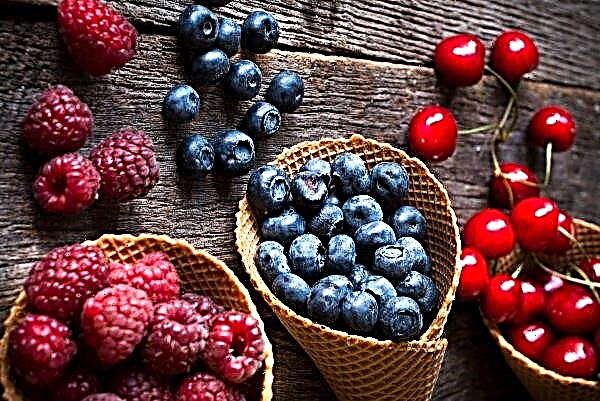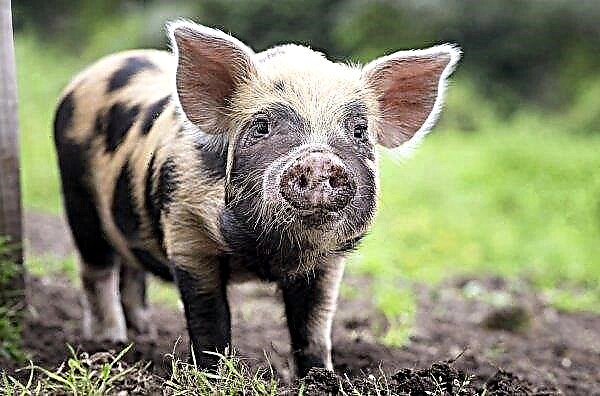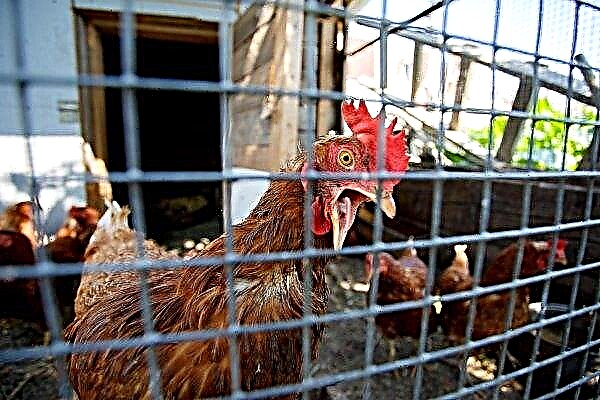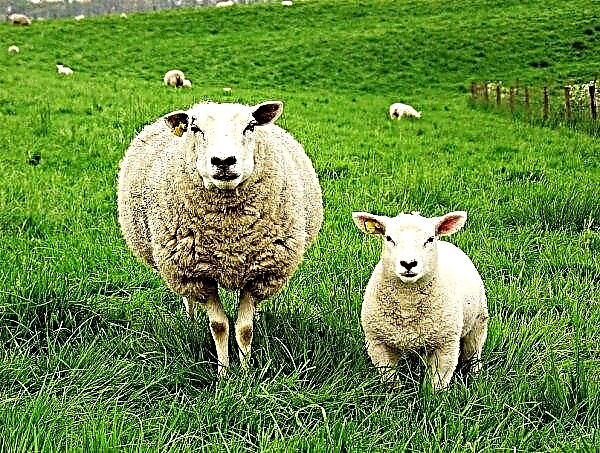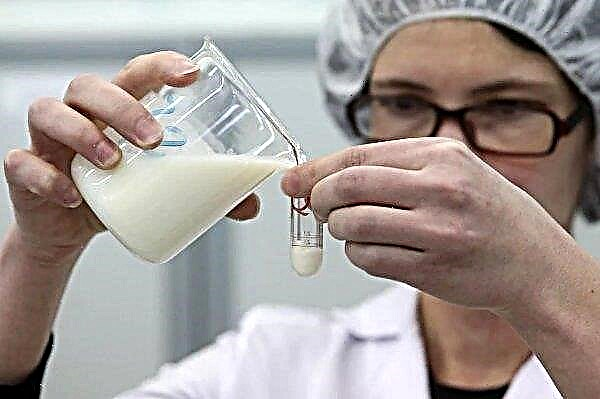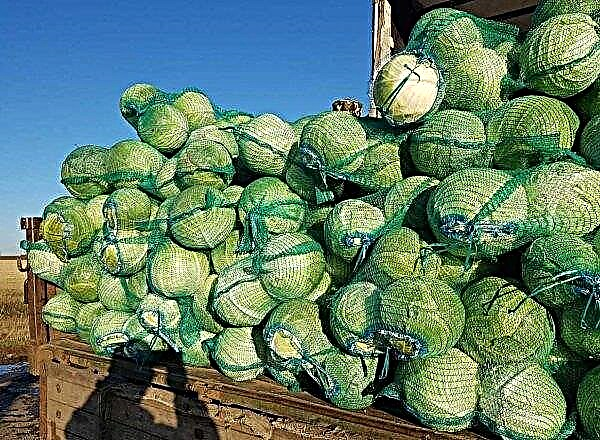Choosing a variety of cauliflower often becomes a problem for the owner of the suburban area. For it to become successful, it is necessary to take into account climatic conditions, soil composition and acidity. Below you will find a detailed description of the best varieties of this variety of cabbage of different ripening dates for cultivation in the open ground.
The best varieties for growing
For cultivation in open ground, varieties of early, mid-early and late ripening are suitable. They differ in leaf shape, head size, density and color.
Early grades
Early varieties include varieties whose growing season lasts 90–110 days. You can try this cabbage already starting in June. Sowing seedlings is carried out in March.
Early cabbage is unsuitable for storage. The heads should be consumed in the next 14 days after harvesting or frozen.Did you know? A lover of growing giant vegetables from America, John Evans managed to get some of the largest types of cabbage in the world. White-skinned weighed 34.4 kg, color - 27.5 kg, broccoli - 15.8 kg, Brussels - 14.1 kg.
Below you will find the names and descriptions of the most popular earliest varieties and hybrids. The top 10 included both long-established varietal specimens that have long been proven, and recently bred.
Snowball 123 (Snow globe)
Large cabbage heads of rounded flat shape are formed in cabbage of this variety. Each of them reaches a mass of 0.5–0.9 kg. Productivity is 1.5–2 kg per 1 m².
The variety is valuable due to its good resistance to the main diseases of cruciferous plants and resistance to adverse weather conditions. The cover sheets are self-closing, which helps to protect the head from the effects of scorching sunlight and bad weather, to preserve its snow-white color and integrity.
The heads have excellent taste. They can be used with versatile cooking uses.
Movir-74
This variety of Russian selection, bred for planting in any of the regions of the Russian Federation, including for the middle lane. Heads are round in shape, weighing 0.7–1.3 kg and 15–25 cm long. They can be white or yellow in color. The structure is very dense. The heads contain from 3 to 5% sugar and 10% solids. They are suitable for fresh cooking, for canning and pickling.
The grade yield is 2.5–4 kg / m². Movir-74 is well tolerated by high temperatures and cold.
Did you know? In addition to the white heads of cauliflower, breeders also bred orange, yellow, green and purple.
Vinson f1
The hybrid comes from Holland. Forms a vertical outlet. The head is white, dense, smooth, weighing up to 3 kg. With 1 m² with the right agricultural technology and favorable weather conditions, you can remove 5.8 kg of cabbage. The advantages of the hybrid include excellent taste, good resistance to pathogens and pests, the safety of presentation after transportation, friendly maturation of heads of cabbage.
Alpha
This variety is a product of the work of German breeders. His heads are small, weighing 1.2-1.5 kg. They are dense, rounded in shape, white with a delicate texture. They taste great. They ripen together. Used in cooking with universal purposes. Harvest variety gives from mid-July to late August. The yield level is 3.5–5 kg / m². Thanks to self-closing leaves, the head is kept intact and is not exposed to external influences.
Casper F1
Another hybrid of Dutch breeding. Ripens in a short time - in just 85–95 days. Its productivity is very high - 8-10 kg / m². The heads are tied with a weight of 2–2.5 kg. They are solid, white. To taste, pleasant, tender, juicy. They ripen together.
The variety is special because it tolerates heat and low humidity, without reducing the number of crops and its quality. It is well stored and tolerates transportation. It can be grown in spring, summer and late autumn.
Unibotra
The grade is made in Germany. It is characterized by very large dome-shaped heads weighing 2–2.5 kg, snow-white. This cabbage has well-developed leaves that help maintain the presentation of the head. The taste of the vegetable is high.
The variety is resistant to high temperatures. It can be grown throughout the year.
Whiteaxel F1
Hybrid from the Japanese company Sakata. The leaf rosette of this cabbage is raised, not spreading. The heads are large, rounded flat, white. Characterized by density. The mass of each is up to 2.5 kg.
The hybrid is appreciated because of its high productivity - up to 4.8 kg / m², resistance to high humidity, low temperatures, spring frosts, unpretentiousness in leaving. In cooking, heads are used for universal purposes.
Baldo
The heads mature very early - from planting seedlings into the ground to harvesting, it takes only 55 days. Cabbage is round in shape, weighing 1-2 kg, milky white in color. Her leaves are wide. Taste and commercial qualities are very high.
The hybrid is characterized by good resistance to infection by powdery mildew and fusarium.
You can plant cabbage in 2 stages: in spring and summer. Its productivity is 3.8–5.5 kg.

White perfection
Subject to the recommended planting dates, this hybrid can be harvested twice a season. It forms not too large (weighing 0.9 kg), but dense and strong dome-shaped heads. They are white in color. The inner leaves cover the fruit well, thereby protecting it from bad weather and dirt.

Lekanu F1
Swiss hybrid with very dense large even heads of white color weighing 2-3 kg. This cabbage is growing rapidly and is developing rapidly. Suitable for assembly by conveyor during spring-summer. The heads ripen together. They are used for universal culinary purposes.
A well-developed leaf system allows you to transport the vegetable without losing its presentation. Taste on top.
Did you know? The use of only 130 g of cauliflower completely covers a person’s daily requirement for vitamin C. There are more ascorbic acids in it than in oranges and lemons.
Medium Early Varieties
The period from seedling emergence to head maturation in medium early varieties lasts from 110 to 135 days. They can be stored longer than earlier copies. Sowing seeds for seedlings should be made from April 10 to May 12.
Goodman
Breeders from Holland worked on the cultivation of the variety. They managed to get a high-yielding variety, which gives the same size white flat-shaped heads. The weight of one piece is 0.8–1.5 kg. Yield indicators - 3.2–4.6 kg / m².
Cabbage is characterized by a wonderful delicate taste. The heads are fully protected by leaves. With a well-developed root system, the vegetable plant is not afraid of heat and drought. Another advantage is resistance to diseases and harmful insects. Heads are perfectly stored and carry transportation. Thanks to what are suitable for cultivation for sale.
Parisian
Bred in Russia. The variety is distinguished by high productivity (2.2–2.6 kg / m²), almost simultaneous maturation of dense and large heads (weighing 1 kg), excellent curing properties (about 70 days under the necessary conditions), taste characteristics at a high level, good resistance to diseases and frosts.
Fremont F1
The hybrid is famous for its huge heads, which can reach a weight of up to 3-5 kg. It is bred by the Dutch. The plant is powerful. Able to independently cover the heads with leaves. The heads are rounded, dense, milky white.
The variety is easy to care for. It does not reduce the yield and quality of the fruit in adverse weather conditions.
Amethyst F1
It has the main difference from most of the varieties under consideration - the head is purple. Amethyst became the first hybrid in the world with such a color. Its creators are Dutch breeders. Small heads, reach a mass of 0.7–1.1 kg. They have a very high taste. The yield of the hybrid is high - at the level of 3 kg / m².
Autumn giant
The heads of this variety are large and dense. To taste juicy and tender. The mass of one piece is 850 g.
Autumn giant can withstand cold weather, requires regular watering, fertilizing and hilling. Its main advantages are a high level of productivity and excellent presentation of the heads.
Cheddar F1
This hybrid forms orange heads - this indicates that they have an increased content of beta carotene. They are characterized by density, a flat-circular shape, a mass of 1-2 kg. Taste and commodity characteristics of the heads at the highest level.
Hybrid can be grown from early spring to late autumn. Harvest is used for universal purposes.
Late grades
Late varieties ripen in 150 days or longer. They are cultivated in regions with a mild climate, so that the first frosts do not catch the crop. Harvesting the last cabbage can be done until late autumn.
Varieties and hybrids with a long growing season in the right conditions can be stored for several months.
Cortes F1
High-yielding hybrid from the Swiss company Syngenta. It is considered the best among later species. Forms white heads with excellent taste and marketability. The weight of 1 piece is from 2 to 3 kg. It is characterized by an absolute level of self-concealment. The heads are suitable for fresh use, processing and freezing. The hybrid gives stable and high yields only in fertile soils and requires regular mineral top dressing.
The hybrid gives stable and high yields only in fertile soils and requires regular mineral top dressing.
Summer resident
The undoubted advantages of the variety are: unpretentiousness to the conditions of cultivation and care, stress resistance, versatility of use, good taste, long fruiting period. The heads are formed dense, rounded, slightly flattened, with a fine-grained structure. The weight of 1 piece is 0.4-0.8 kg.
The basic rules of growing
Cauliflower is most often cultivated using seedlings. Only in regions with a mild climate can sowing be carried out immediately on open beds.
Cabbage seeds are sown on seedlings from late March to mid April. Before sowing, you need to purchase or prepare containers for seedlings, the soil mixture and process the seeds.
The soil mixture can be purchased at a specialized store or made by hand, mixing in equal parts turf land, humus, peat. It should be loose, with good moisture and air conductivity, with neutral or slightly alkaline acidity. Do-it-yourself soil needs to be disinfected. It is kept in the oven, over steam, in the microwave, watered with boiling water or potassium permanganate. Before sowing, the soil must be well moistened.Important! Properly prepared seeds and soil before sowing further increase cabbage yield by about 30%.
Seeds are selected the largest. First, they are immersed for 20 minutes in water heated to a temperature of + 50 ° C, then soaked for 8 hours in a solution of potassium permanganate.
When landing, you must adhere to the following technology:
- In a moist soil mixture, make grooves 1 cm deep, observing 3 cm intervals.
- Deepen the seeds into the grooves.
- Sprinkle with soil.
- Seal a little.
- Send the tank to a room with a temperature of + 18 ... + 20 ° С.
 During the growth, seedlings should be fertilized twice. The first time - 10 days after planting in separate containers. The second - after waiting another 10 days. A mixture of superphosphate, potassium-containing fertilizers diluted in water (20 g + 10 g + 10 l) is used.
During the growth, seedlings should be fertilized twice. The first time - 10 days after planting in separate containers. The second - after waiting another 10 days. A mixture of superphosphate, potassium-containing fertilizers diluted in water (20 g + 10 g + 10 l) is used.2 weeks before moving to the bed, the seedlings are taken out into the open air daily, starting from 40 minutes a day, gradually increasing the duration of the hardening procedure.
Sprouts of early varieties are moved to open ground when the threat of frost passes - from late April to mid-May. Planting mid-early cabbage is produced from mid-May to mid-June, and late - in July. At this time, seedlings will reach the age of 35-50 days. The first time it will need to be hidden from the sun.
For cultivation, choose a quiet, sheltered from the winds section, which is well lit by the sun. The soil should be neutral or slightly alkaline. Cauliflower does not grow in acidic soils.Important! It is best to plant cauliflower after siderata, carrots, onions, grains, cucumbers, potatoes. Bad predecessors for this vegetable crop are all representatives of the cruciferous family, tomatoes, beets, radishes, turnips, radishes.
The plot is prepared in the fall. It is thoroughly cleaned, dug up and fed with manure or compost at the rate of 4-5 kg / m². If necessary, reduce acidity by adding lime.
Seedlings are planted in the garden in cloudy dry weather or in the evening, after the sun sets.
For different species, varieties and hybrids, there are separate recommendations for the planting scheme. Most often, sprouts are planted using schemes of 35 × 50 cm, 50 × 50 cm, 60–70 × 35 cm.
In the future, the owner of the garden should allocate time for regular watering, soil care, fertilizing, preventive measures against diseases and harmful insects.
Watering is done once a week. In the hot period, 2 times a week is allowed. Water of room temperature will be required. Cabbage is watered under the root, trying to avoid getting drops on the leaves and inflorescences. The procedure is best done in the evening.
Loosening is carried out the day after watering or rain. Recommended depth is 6 cm.
Soil care also involves regular weeding and mulching.
Hilling is done twice a season: the first time - 14 days after planting in the beds, the second - 10 days after the first procedure. Sapa or rake the soil sprinkled with a hill 30 cm high to the stem, pulling it from a distance of 25 cm. Hilling allows you to prevent the development of the black leg, to avoid colonization of the cabbage fly, to strengthen the root system.
Feeding is important for a good harvest. It is better to give preference to organic fertilizers. After 3 weeks, cabbage can be fed with mullein. Subsequently, dry wood ash is used (1 tbsp / m²). Also, the plant responds well to mineral fertilizers. They can be applied three times a season. Superphosphate, nitroammophosk, complex fertilizers are used. During the fruiting period, ammonium nitrate (30 g), superphosphate (80 g), potassium fertilizers (20 g) are added. Such a mixture is diluted in a bucket of water.When the heads are formed, in varieties that do not independently cover them with leaves, 2 leaves should be tied on top. Thus, it will be possible to achieve the preservation of white color and not be afraid that the head will decay.

Features of storage and application of the crop
In order to keep the crop longer, it is important not to let the cabbage overripe, become yellow and immediately after cutting, remove it from the sun. The heads are cut with a sharp knife when they reach a diameter of 8–12 cm and a weight of 0.3–1.2 kg, leaving 2–4 leaves.
Cauliflower is stored in several ways:
- In the cellar at a temperature of 0 ° C and a humidity of 90–95%. The heads are placed in wooden or plastic boxes and covered with polyethylene. Duration of storage - up to 2 months.
- In the cellar in limbo. Shelf life - up to 3 weeks.
- In fridge. The longest stored heads are laid in plastic bags. Shelf life - 1 week.
- In the freezer. You can freeze raw and boiled cabbage. You can use such a product throughout the year.
Cauliflower is most often consumed in boiled or fried form. Her taste is mild, so as a separate dish she is not served, only baked in batter. But for cooking dishes such as casseroles, salads, stews, soups, it fits perfectly. Also, it is filled with pies, other vegetables, cutlets are made from it.Important! Frozen food should be consumed immediately after thawing.Re-freezing is excluded.
We hope that after reading the article, it will be easy for you to decide which variety or hybrid of cauliflower to choose for your summer cottage. Caring for this vegetable crop is not easy. However, knowing all the nuances of growing and vegetable preferences, a novice gardener can also cope with it.

